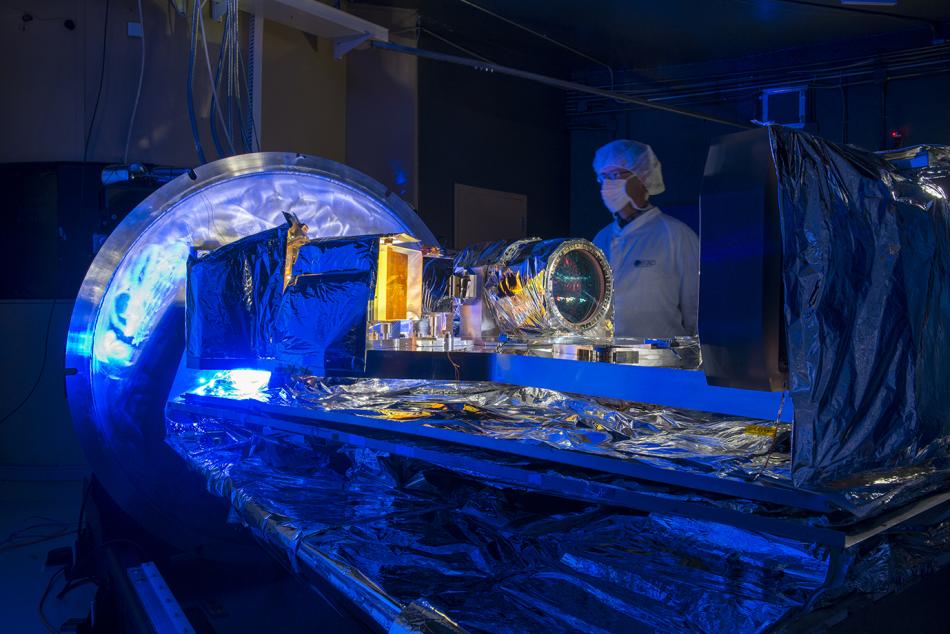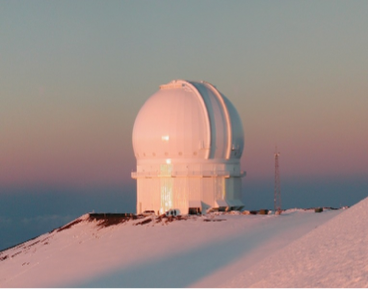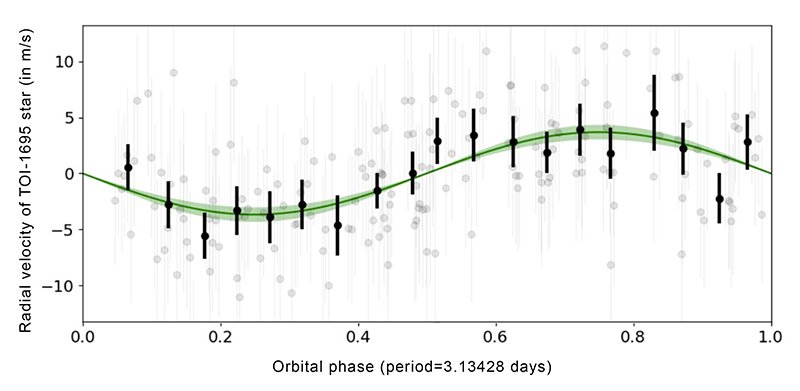SMALL PLANETS ORBITING LOW-MASS STARS DETECTED WITH THE SPIROU INSTRUMENT AND THE TESS SATELLITE
Since the discovery in 1995 of a planet in orbit around a star other than the Sun, research in exoplanetology has revolutionized our knowledge of planetary systems. The SPIRou instrument, installed at the Canada-France-Hawaii Telescope, contributes to these results, in particular by observing the possible planets identified by the TESS observatory satellite. By combining the data from both instruments, the planet TOI-1695b is discovered, and is one of the new sub-Neptune and super-Earth type planets revealed by SPIRou around stars less massive and cooler than the Sun, by an international team in which the Institut d'astrophysique de Paris plays a major role. These results help to better understand this type of planets that do not exist in the Solar System.
For centuries, only the planets of the Solar System were known and observed: four giant planets far from the Sun, and four telluric planets (including Earth) closer to our star. In modern 19th and 20th century thought, it seemed very likely that many, if not all, other stars also hosted planets; being inaccessible to our means of observation, these remained however in the domain of the imaginary or of science fiction. It was therefore not known whether these possible extrasolar planets really existed, were similar to those of the Solar System, or had different properties.
The situation changed in 1995 with the first detection of an extrasolar planet, carried out at the Haute-Provence Observatory by astronomers Michel Mayor and Didier Queloz, later awarded the Nobel Prize in Physics. New instruments have since been developed; they have enabled the detection and characterization of thousands of exoplanets, revolutionizing our knowledge of planetary systems, and in particular of their formation and evolution.
Among these, France and the Institut d'astrophysique de Paris have made a major contribution to the development of the SPIRou instrument (Figure 1) at the Canada-France-Hawaii Telescope (Figure 2), installed on the Big Island of Hawaii. It is a spectropolarimeter (see box 1) operating in the infrared range. It makes it possible to search for planets around stars less massive, smaller and less hot than the Sun, the red dwarfs (their temperature is between 2500 and 4000°C, while the Sun is at 5500°C). It also makes it possible to study the magnetic activity of these small stars, which are the most numerous stars in our galaxy. The scientific teams use SPIRou in particular to characterize the candidate planets (objects likely to be planets) which have been identified around red dwarf stars by the Transiting Exoplanet Survey Satellite (TESS), a NASA observatory satellite, and which should be observed with SPIRou to establish their nature.
 Figure 1: The SPIRou instrument during its integration into the Canada-France-Hawaii Telescope Credit: S. Chastanet, OMP/IRAP/CNRS. |
 Figure 2: The CFHT telescope atop Mauna Kea. Credits: J.-C. Cuillandre, TCFH. |
1. SPIRouSPIRou is an infrared spectro-polarimeter which began its observations in 2018 at the Telescope-Canada-France-Hawaii. It is an instrument which observes the stars by spectroscopy (the distribution of light according to the wavelength) and polarimetry (a privileged distribution of the orientation of the electromagnetic waves emitted), in the infrared domain. It aims in particular to search for and characterize telluric planets in the habitable zone (the zone neither too far nor too close to the star, so as to allow the presence of liquid water on the surface of the planets) around stars that are not very massive, and to study the impact of the magnetic field on the formation of stars and planets. This project is carried out by institutions located in France, Canada, the United States, Brazil, Portugal, Switzerland and Taiwan. The Île-de-France’s region contribution to SPIRou brings together members of several laboratories, with a financial support from the DIM-ACAV and of the Île-de-France Region, that is coordinated by the Institut d'astrophysique de Paris. |
It is in this context that researchers from the Institut d'astrophysique de Paris, and in particular Flavien Kiefer (collaborator and former postdoctoral fellow at the IAP), Eder Martioli (IAP associate researcher and former postdoctoral fellow at the IAP), Guillaume Hébrard (senior CNRS researcher), Alain Lecavelier des Étangs (senior CNRS researcher) and Pierre-Cécil König (former PhD student at the IAP) present the discovery and characterization of the new planet TOI-1695b, carried out within an international team. Barely twice as big but six times more massive than the Earth, this new planet has a density therefore slightly lower than that of the Earth. It is of the sub-Neptune type, that is to say a planet a little smaller than Neptune. Its temperature, however, is a few hundred degrees higher than that of Neptune, and its atmosphere most likely contains large amounts of hydrogen, helium, and water vapor. Finally, this planet goes around its red dwarf star in three days (Figure 3).
 Figure 3: : Radial velocity of the star TOI-1695 measured with SPIRou showing that the star moves away and approaches us periodically. These variations make it possible to detect and characterize the sub-Neptune-type planet TOI-1695b that it hosts (Kiefer et al. 2022). Indeed, the radial velocity method is an indirect method for detecting and characterizing extra-solar planets. It is based on the gravitational interaction between a planet and its star: if it is mainly the planet that revolves around its star, which is much more massive, the planet nevertheless slightly disturbs the movement of its star. By very precisely measuring the movement of the star, and more particularly its radial velocity, we can deduce that it hosts a planet in orbit around it. Credits: Kiefer et al. (2023). |
A few weeks ago, the same team had already announced the discoveries of the super-Earth TOI-1452b (a super-Earth is a planet slightly larger than Earth) and the the sub-Neptune TOI-1759b. Like TOI-1695b, these two planets orbit a red dwarf star. The size of these three planets is between 1.7 and 3.1 times that of Earth, and their masses between 5 and 7 times that of Earth. They are therefore intermediate planets between Earth and Neptune, but they are closer to their host stars (from 6 to 18 million km, compared to the 150 million km of the Earth-Sun distance). Non-existent in the Solar System, observation programs have shown for several years that these super-Earths and sub-Neptunes are nevertheless very abundant in our galaxy. These new planets detected and characterized with SPIRou will make it possible to better understand this new planetary population. One wonders in particular how, in the history of their formation, some could have become gaseous planets for some or rocky planets for others, despite similar masses. Answering this question could help explain the dichotomy of the planets of the Solar System, between small telluric planets and gas giant planets.
Articles
![]() Article in Astronomy & Astrophysics: Kiefer, Hébrard, Martioli, Artigau, Doyon, Donati, Cadieux, Carmona, Ciardi, Cristofari et al., 2023, “A sub-Neptune planet around TOI-1695 discovered and characterized with SPIRou and TESS”
Article in Astronomy & Astrophysics: Kiefer, Hébrard, Martioli, Artigau, Doyon, Donati, Cadieux, Carmona, Ciardi, Cristofari et al., 2023, “A sub-Neptune planet around TOI-1695 discovered and characterized with SPIRou and TESS”
![]() Article in The Astronomical Journal: Cadieux, Doyon, Plotnykov, Hébrard, Jahandar, Artigau, Valencia, Cook, Martioli, Vandal et al. 2022 (AJ 164 96) “TOI-1452b: SPIRou and TESS Reveal a Super-Earth in a Temperate Orbit Transiting an M4 Dwarf”
Article in The Astronomical Journal: Cadieux, Doyon, Plotnykov, Hébrard, Jahandar, Artigau, Valencia, Cook, Martioli, Vandal et al. 2022 (AJ 164 96) “TOI-1452b: SPIRou and TESS Reveal a Super-Earth in a Temperate Orbit Transiting an M4 Dwarf”
![]() Article in Astronomy & Astrophysics : Martioli, Hébrard, Fouqué, Artigau, Donati, Cadieux, Bellotti, Lecavelier des Étangs, Doyon, do Nascimento et al. 2022 (A&A 660, A86) “TOI-1759b: A transiting sub-Neptune around a low mass star characterized with SPIRou and TESS”
Article in Astronomy & Astrophysics : Martioli, Hébrard, Fouqué, Artigau, Donati, Cadieux, Bellotti, Lecavelier des Étangs, Doyon, do Nascimento et al. 2022 (A&A 660, A86) “TOI-1759b: A transiting sub-Neptune around a low mass star characterized with SPIRou and TESS”
Links
![]() News of INSU/CNRS, scientific result in the theme “Universe” (in French), February 13, 2023: “Des petites planètes en orbite autour d'étoiles naines rouges ont été détectées”
News of INSU/CNRS, scientific result in the theme “Universe” (in French), February 13, 2023: “Des petites planètes en orbite autour d'étoiles naines rouges ont été détectées”
![]() SPIRou: an infrared spectro-polarimeter
SPIRou: an infrared spectro-polarimeter
Writing and contact
- Guillaume Hébrard
Institut d’astrophysique de Paris, CNRS, Sorbonne Université
guillaume [dot] hebrard [at] iap [dot] fr
Other contacts
- Flavien Kiefer (collaborator and former postdoctoral fellow at the IAP)
Institut d’astrophysique de Paris, CNRS, Sorbonne Université
Laboratoire d'Etudes Spatiales et d'Instrumentation en Astrophysique (LESIA), Observatoire de Paris
flavien [dot] kiefer [at] iap [dot] fr - Eder Martioli (IAP associate researcher and former postdoctoral fellow at the IAP)
Institut d’astrophysique de Paris, CNRS, Sorbonne Université
Laboratório Nacional de Astrofísica, Itajubá, Brésil
eder [dot] matioli [at] iap [dot] br
Web writing: Valérie de Lapparent
Layout: Jean Mouette
February 2023
